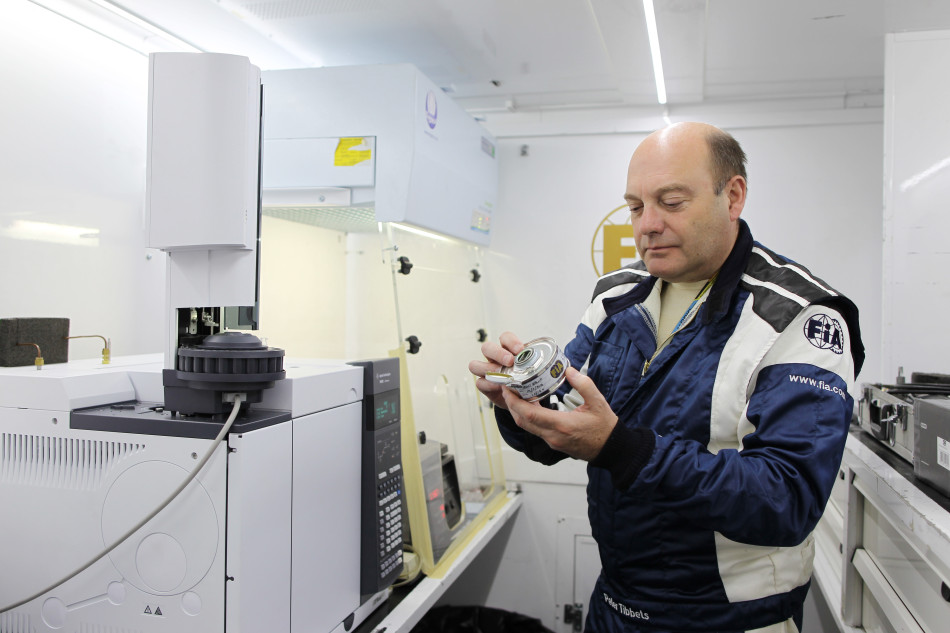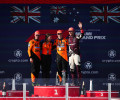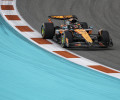The Watchmen Part 3: Levelling the playing field

While the introduction of F1’s new power unit is undoubtedly the most dramatic change to this year’s regulations, there have been significant alterations elsewhere, no more so than in fuelling, with cars now limited to 100kg of fuel per race and with efficiency also promoted through fuel flow restrictions. Those changes and the reintroduction of turbocharging to F1 have given fuel analyst Peter Tibbetts a new environment in which to work.
“The first change is in the fuel approval process because every team has to have their fuel pre-approved. Last year we were having the density checked at three different temperatures to get a density temperature curve plotted. The fuel flow meter measures volume and we have to convert that to mass because the regulations are measured in mass,” he says. “Therefore we have to get a temperature density curve during the fuel approval process, which is then programmed into the fuel flow sensors.
“At the circuit, because the fuel flow sensor is mounted in the tank, we have to check that the sensor has got the correct FIA seal and that it’s been calibrated with the correct fuel,” he adds. “Some teams have more than one fuel pre-approved for the season and a sensor can be calibrated against two or three different fuels. We have to make sure that the correct calibration line is put into the software in the fuel flow sensor so that it is measuring the correct fuel.”
The return of turbos to the sport has also changed the types of fuel used.
“The fuel composition has changed quite a lot,” says Tibbetts. “It’s much better to have a heavier, more dense fuel for a turbocharged engine than with a normally-aspirated engine.”
All these on-circuit checks, which take place after every track session and before and after the race, are carried out in Tibbetts’ travelling laboratory. “I normally set up in one of the ‘track shacks’ for flyaway races or in one of the trailers in Europe,” he says. “And what I set up is an instrument called a gas chromatograph. This is used to separate the fuel into its individual components so we can see exactly what’s in there. I’ll get a fingerprint, a pattern of peaks unique to that fuel, and when I take a fuel sample I can overlay that pattern against the one I have for the reference fuel and compare the two. They should overlap completely.
“The samples are taken in the garage where we’ve got marshals making sure nothing’s touched on the car, apart from filling it up with petrol and changing oils and fluids – and things that Jo Bauer allows to be done due to damage or something. I’ll go along an hour before the race, take a sample, and then take it back to the gas chromatograph, and I’ll set the samples up to run during the race. I take three more samples at the end of the race. During the weekend every team is sampled at least once. I generally take 12 samples over the weekend and there are 11 teams, so even if I take a sample from a team they know there’s a chance I might go back and take another one.”
Changes, too, have occurred in the gearbox where, as technical assistant Richard Darker explains, Formula One’s teams are also being tested.

“This year the cars have eight forward gears, which is new, and the teams have to nominate the ratios they will use in their gearboxes during the year,” he says. “It’s pretty tough. Last year they had 30 plus gears to choose from and now they’ve got only eight. They’ll choose those, we’ll seal the gearbox and they’ll run each gearbox for six events.”
There are ‘get-out-of-jail’ clauses, however. Normally teams are only allowed to change certain elements inside the gearbox during a race weekend if they can prove to Bauer they’ve been damaged. For 2014, however, that rule has been relaxed, with teams now getting five opportunities during the season to open the gearbox without proof of damage being required. Also, for this year only, teams have been given the chance to re-nominate their gear ratios once during the season, although after that change is made they must race the remainder of the year with the new set.
Unusually, it means that for Darker it will be a more straightforward season than in the past. “It’s a good year for me!” he laughs. “Normally, the teams would see what gear ratios they wanted out of the 30, and then two hours after second practice they would send a list to me and Jo. Then on a Friday night I’d go round and seal every gearbox. This year I won’t have to do that as the ratios are set from Melbourne.”
But where one door of complexity closes, another opens. Darker also takes care of deflection tests and looks after the weigh bridge in the FIA garage, where he’ll spend long hours checking the correctness of the cars against new bodywork and chassis regulations.
“Teams can request their own time to come and use our equipment, to try out a front or rear wing or anything like that. After each practice session cars can be weighed, and after qualifying the top 10 cars will be weighed. Then we’ll choose three to four cars and do a specific test on them.”
Deflection tests have been the area of most scrutiny in recent times, and the possibility that teams have used wings that illegally flex under load to provide improved downforce has been heavily investigated.
“We saw it a lot in pre-season tests, this aero-elasticity,” says Bauer. “Of course the teams can run what they like in testing, it’s not regulated, but it is from Melbourne onwards. I saw some things on the cars we wouldn’t accept this year, like spring-loaded flaps. It’s not something they should put on a car. Having a spring action for any mechanism with an aero influence is not permitted.”
This is the eternal contest between competitors and adjudicator, however, a battleground where the teams are constantly in pursuit of an area within the definitions of what an F1 car is that can be re-imagined and exploited for a gain in lap time. In opposition, the FIA technical team is there to determine whether that re-imagination conforms to the rulebook or contravenes it.
Bauer is sanguine about the nature of the game, though. “This is how it is,” he says. “They have some very clever people and it’s our job to try to understand how they work.
“If we see something, I’ll discuss it with Charlie Whiting, and if we don’t like it we’ll advise the team to fix it. If we spot it in free practice we’ll ask for it to be changed by qualifying. If they don’t or if we find after qualifying that something significant is wrong, then we’ll report it to the stewards as we have done in the past.”
Bauer does admit that due to the difficulties of getting the hugely complex 2014 cars up and running he expects fewer attempts to push the rules envelope – at least initially.
“At the moment they’re all trying to simply understand their cars, so I think at least in the first half of the season it’s less likely. However, that doesn’t mean we won’t get to the stage of the teams trying to find loopholes again. As I said, they have all these incredibly smart brains working there, and we have to match them somehow.
“It is a constant battle,” he concludes. “You can never un-invent the things they bring to cars, but you can make it harder for them to achieve the things they’d like to achieve.”

 Facebook
Facebook Twitter
Twitter






